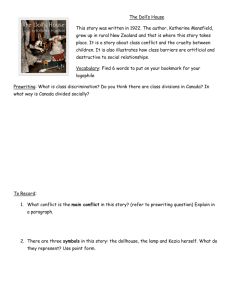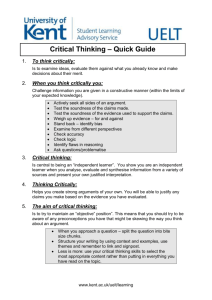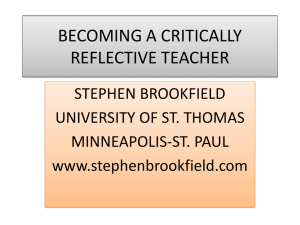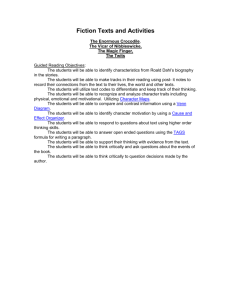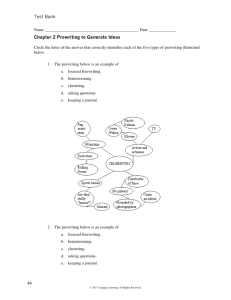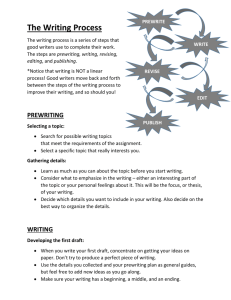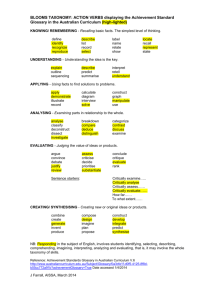Critical Thinking Skills
advertisement
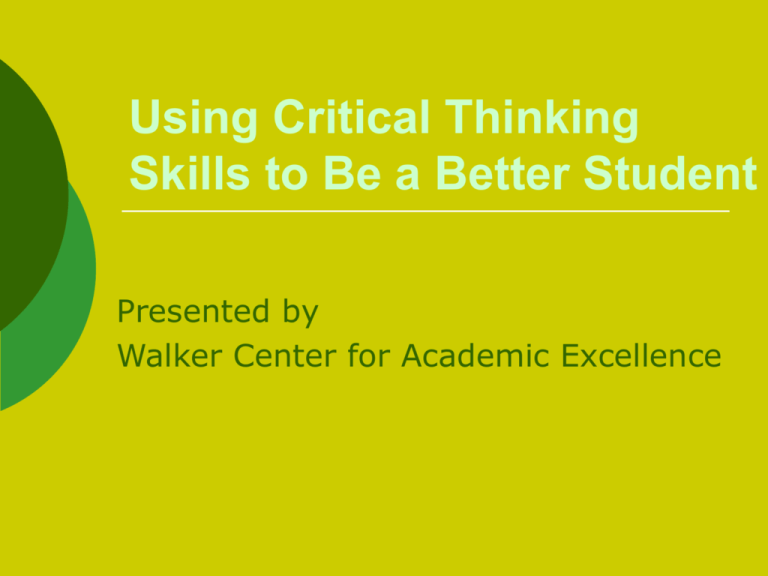
Using Critical Thinking Skills to Be a Better Student Presented by Walker Center for Academic Excellence Stop and Think… What What is Critical Thinking? does the term Critical Thinking mean to you? Critical Thinking - Defined A purposeful, organized, mental process that we use to understand the world and make informed decisions. Critical Thinking involves asking questions to come up with potential solutions to different problems. What is Critical Thinking? Productive: Thinking that goes beyond observing and recalling facts Critical: Being able to ask questions and gather information Weighing & Solving: When you think critically you weigh evidence, solve problems and make decisions Creating & Applying: When you think critically you create new ideas, and turn information into a tool by applying what you have learned in previous situations to new situations Stop and Think… Can you think of a time when you had a critical thinking response to a situation? What did you do? Example: You had to get a B on a paper to pass a course but you got a C-. A non-critical thinking response would be to say that you did not pass the course. A critical thinking response would identify potential solutions like asking the instructor if you can redo the paper, asking if you can do another assignment to add another grade to your average, or retaking the course. Think about the example. One way, the case is closed. The other way, options are revealed and explored, possibilities open up and you can take action to improve the situation. Can you think of a time when you had a non-critical thinking response to a situation? What could you have done differently? Stop and Think… How can you incorporate the principles of critical thinking into your academic life? Critical Thinking & College Being able to think critically in college will help you better understand what you learn. Evaluate different perspectives: Evaluate other people’s ideas. How do they conflict with yours? How are they similar? Ask open-ended questions (Why? How? What if?): This will assist you in gathering more information and narrow your focus when faced with an overwhelming problem. Explain your answers: If you “own” your thoughts and are responsible for creating them, you will be better able to explain what you are thinking and answer questions. Critical Thinking and College Learn to think more critically in all aspects of your education. The following slides discuss: Active Learning Active Reading Critical Writing Stop and think… What does it mean to be an active learner? What does it mean to be an active learner? Getting involved instead of remaining disengaged in the classroom: asking questions, taking notes, thinking as you are listen, conversing with other students and the instructor about ideas. Taking initiative to make your own decisions instead of waiting passively to be told what to do. Following through on commitments and assignments instead of giving up. Taking responsibility for your decisions and thoughts instead of blaming others or events “beyond your control”. Tips for Active Learning If possible, choose instructors that actively engage you in the classroom. Prepare for class by reading your textbook and reviewing notes from previous classes. Ask questions. Put what you learn into your own words. Summarize your notes and readings. Tips for Active Learning (continued) Study with other students. Talking about assignments and getting other points of view will help you learn the material faster and more thoroughly. Thinking critically about others’ opinions and thoughts helps to clarify your own. Use your resources. Instructors, other students, the library, tutors, academic advisor, books, etc. The more people and resources you form working relationships with, the better your chance of success in reaching your goals. Being Active What specific things can you do to increase your level of active learning? The next slide begins the discussion on active reading… Stop and think… What does it mean to be an active reader? What can you do as you read to increase your understanding of the material? Active Reading To understand what you read, you must be able to: Identify the author’s thesis (main idea). Understand the author’s line of reasoning from paragraph to paragraph. Briefly explain the main point and line of reasoning to someone who has not read the passage. Tips for Reading Actively Pause after reading each paragraph to mentally summarize what have read. Ask yourself: What is the main idea? What are the major supporting facts? Where is the discussion likely to go from here? Focus on: Understanding the main idea Identifying supporting evidence Distinguishing between main points and minor details The next slide lists key words and phrases that authors use to signal how a discussion is organized. Being aware of these words and phrases will help you understand the main idea and details of a passage. Signal Words & Phrases These words signal that the author is contrasting (identifying differences between) two concepts: Alternatively, rather than, by contrast, while, however, yet, on the other hand These words signal that the author is comparing (identifying similarities between) two concepts: Similarly, just as, in the same way, to, analogous, also, parallel, as, likewise These words signal evidence (factual information) used to support the author’s argument: Because, since, in light of These words signal a logical conclusion based upon preceding material: Consequently, therefore, in conclusion, as a result, then, accordingly, thus Being Active What specific skills can you work on to increase your level of active reading? The next slide begins the discussion on active writing… Stop and think… Do you have a process for approaching writing assignments? How productive is it? How could you improve your writing? Critical Writing Three steps to better writing: 1. Prewriting 2. Writing (drafting) 3. Rewriting (revising) Prewriting Prewriting includes: Preparing to write by reading assigned works, completing your research, taking notes and creating outlines Exploring the topic by asking questions which you will eventually answer in your essay/paper Writing your rough ideas which you will come back to and expand on Prewriting should take up most of your time during the writing process. Writing If you have done the proper prewriting/thinking/researching/note taking/outlining, your thoughts will already be developed and your mind will be primed and ready for the task of writing. Thus, writing the first draft should take a limited amount of your time during the writing process. Rewriting After completing the first draft, you need to revise, edit and rewrite Work with a writing tutor in the Walker Center to get feedback and learn ways to improve your writing. To make an appointment email tutor@peirce.edu or call 1-888GO-PEIRCE, extension 9251. Rewriting will take more time than writing your first draft. Tips for Critical Writing Be willing to say, “I don’t know”. Don’t jump to conclusions too quickly: good questions take time and patience to answer. Don’t substitute a strong belief for real knowledge or fact. Test your opinions in light of the evidence and be willing to change your mind. Explain your point of view with evidence. Judge an argument on its merits, not on the basis of who said it. Use reliable scholarly resources. Access research databases and get assistance from the Peirce Library staff. You can access the library online at library.peirce.edu Critical Thinking Summary Think critically by applying your current knowledge to new situations. You can incorporate critical thinking skills into your academic life by evaluating different perspectives, asking questions and explaining your answers. Be an active learner by asking questions, getting involved, and taking responsibility. Read actively by summarizing in your own words and looking for signal words to help you better understand main points and details. Improve your writing by prewriting, drafting and revising. Resources Carter, C. et al. Keys to Success: How to achieve your goals. Upper Saddle River, NJ: Prentice Hall, 1999. Carter, C. et al. Keys to Success: How to achieve your goals, Adopter’s Resource Kit. Upper Saddle River, NJ: Prentice Hall, 1998. Chaffee, J. Thinking Critically, 7th edition. Boston: Houghton Mifflin Company. 2003 Gardner, J. & Jewler, A. Your College Experience; Strategies for Success,4th Edition. Belmont, CA: Wadsworth Publishing Compan, 2000. Steward, M. & O’Toole, F. 30 Days to the LSAT. Lawrenceville, NJ: Thomson Corporation. 1998
